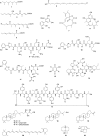Significant natural product biosynthetic potential of actinorhizal symbionts of the genus frankia, as revealed by comparative genomic and proteomic analyses
- PMID: 21498757
- PMCID: PMC3127629
- DOI: 10.1128/AEM.00038-11
Significant natural product biosynthetic potential of actinorhizal symbionts of the genus frankia, as revealed by comparative genomic and proteomic analyses
Abstract
Bacteria of the genus Frankia are mycelium-forming actinomycetes that are found as nitrogen-fixing facultative symbionts of actinorhizal plants. Although soil-dwelling actinomycetes are well-known producers of bioactive compounds, the genus Frankia has largely gone uninvestigated for this potential. Bioinformatic analysis of the genome sequences of Frankia strains ACN14a, CcI3, and EAN1pec revealed an unexpected number of secondary metabolic biosynthesis gene clusters. Our analysis led to the identification of at least 65 biosynthetic gene clusters, the vast majority of which appear to be unique and for which products have not been observed or characterized. More than 25 secondary metabolite structures or structure fragments were predicted, and these are expected to include cyclic peptides, siderophores, pigments, signaling molecules, and specialized lipids. Outside the hopanoid gene locus, no cluster could be convincingly demonstrated to be responsible for the few secondary metabolites previously isolated from other Frankia strains. Few clusters were shared among the three species, demonstrating species-specific biosynthetic diversity. Proteomic analysis of Frankia sp. strains CcI3 and EAN1pec showed that significant and diverse secondary metabolic activity was expressed in laboratory cultures. In addition, several prominent signals in the mass range of peptide natural products were observed in Frankia sp. CcI3 by intact-cell matrix-assisted laser desorption-ionization mass spectrometry (MALDI-MS). This work supports the value of bioinformatic investigation in natural products biosynthesis using genomic information and presents a clear roadmap for natural products discovery in the Frankia genus.
Figures



Similar articles
-
Expanding our understanding of sequence-function relationships of type II polyketide biosynthetic gene clusters: bioinformatics-guided identification of Frankiamicin A from Frankia sp. EAN1pec.PLoS One. 2015 Apr 2;10(4):e0121505. doi: 10.1371/journal.pone.0121505. eCollection 2015. PLoS One. 2015. PMID: 25837682 Free PMC article.
-
Genomic, transcriptomic, and proteomic approaches towards understanding the molecular mechanisms of salt tolerance in Frankia strains isolated from Casuarina trees.BMC Genomics. 2017 Aug 18;18(1):633. doi: 10.1186/s12864-017-4056-0. BMC Genomics. 2017. PMID: 28821232 Free PMC article.
-
The implication of life style on codon usage patterns and predicted highly expressed genes for three Frankia genomes.Antonie Van Leeuwenhoek. 2008 May;93(4):335-46. doi: 10.1007/s10482-007-9211-1. Epub 2008 Feb 22. Antonie Van Leeuwenhoek. 2008. PMID: 18293096
-
Aspects of nitrogen-fixing Actinobacteria, in particular free-living and symbiotic Frankia.FEMS Microbiol Lett. 2013 May;342(2):179-86. doi: 10.1111/1574-6968.12116. Epub 2013 Mar 28. FEMS Microbiol Lett. 2013. PMID: 23461635 Review.
-
Use of Frankia and actinorhizal plants for degraded lands reclamation.Biomed Res Int. 2013;2013:948258. doi: 10.1155/2013/948258. Epub 2013 Nov 11. Biomed Res Int. 2013. PMID: 24350296 Free PMC article. Review.
Cited by
-
Permanent Draft Genome sequence for Frankia sp. strain CcI49, a Nitrogen-Fixing Bacterium Isolated from Casuarina cunninghamiana that Infects Elaeagnaceae.J Genomics. 2017 Sep 12;5:119-123. doi: 10.7150/jgen.22138. eCollection 2017. J Genomics. 2017. PMID: 28943973 Free PMC article.
-
The re-emergence of natural products for drug discovery in the genomics era.Nat Rev Drug Discov. 2015 Feb;14(2):111-29. doi: 10.1038/nrd4510. Epub 2015 Jan 23. Nat Rev Drug Discov. 2015. PMID: 25614221 Review.
-
Prescreening bacterial colonies for bioactive molecules with Janus plates, a SBS standard double-faced microbial culturing system.Antonie Van Leeuwenhoek. 2012 Aug;102(2):361-74. doi: 10.1007/s10482-012-9746-7. Epub 2012 May 5. Antonie Van Leeuwenhoek. 2012. PMID: 22562433 Free PMC article.
-
Draft Genome Sequence of the Symbiotic Frankia sp. strain B2 isolated from root nodules of Casuarina cunninghamiana found in Algeria.J Genomics. 2020 Jan 19;8:11-15. doi: 10.7150/jgen.38461. eCollection 2020. J Genomics. 2020. PMID: 32064004 Free PMC article.
-
Genome features of the endophytic actinobacterium Micromonospora lupini strain Lupac 08: on the process of adaptation to an endophytic life style?PLoS One. 2014 Sep 30;9(9):e108522. doi: 10.1371/journal.pone.0108522. eCollection 2014. PLoS One. 2014. PMID: 25268993 Free PMC article.
References
-
- Alloisio N., et al. 2007. Frankia alni proteome under nitrogen-fixing and nitrogen-replete conditions. Physiol. Plant. 130:440–453
-
- Alloisio N., Marechal J., Heuvel B. V., Normand P., Berry A. M. 2005. Characterization of a gene locus containing squalene-hopene cyclase (shc) in Frankia alni ACN14a, and an shc homolog in Acidothermus cellulolyticus. Symbiosis 39:83–90
-
- Alloisio N., et al. 2010. The Frankia alni symbiotic transcriptome. Mol. Plant Microbe Interact. 23:593–607 - PubMed
-
- Altschul S. F., Gish W., Miller W., Myers E. W., Lipman D. J. 1990. Basic local alignment search tool. J. Mol. Biol. 215:403–410 - PubMed
-
- Bagnarol E., et al. 2007. Differential Frankia protein patterns induced by phenolic extracts from Myricaceae seeds. Physiol. Plant. 130:380–390
Publication types
MeSH terms
Substances
Grants and funding
LinkOut - more resources
Full Text Sources
Other Literature Sources

